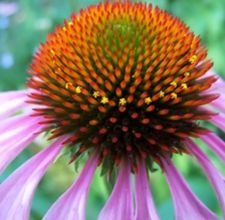The term "coneflower" refers to the common name of species belonging to the botanical genus Echinacea. Coneflowers have protruding, prickly centers and daisy-like petals that come in a range of colors. The petals tend to droop slightly downward, combining with the center of the flower to give the entire flower head a conelike shape. As native plants, coneflowers grow easily throughout much of North America.
Features of Echinacea
-
Botanists currently recognize 11 species of coneflower, which share several key traits. Coneflowers belong to the composite plant family, meaning that their bristly centers actually consist of dozens of tiny flowers surrounded by a single corona of petals. They are perennial plants, and their multiple tall stems grow back annually from the root system, which typically consists of a taproot. Foliage grows beneath the flower heads. The centers are the chief defining characteristic. The name Echinacea derives from the Greek word for hedgehog and the centers of the flowers do resemble their prickly namesakes.
Relatives
-
Coneflowers resemble daisies, black-eyed Susans and other familiar wildflowers, and it’s no wonder: They all belong to the enormous composite flower family. Close relatives of the coneflower also include sunflowers, dandelions and thistles.
Growing Coneflowers
-
Coneflowers will grow well in USDA zones 3 through 9. In the wild, they typically inhabit meadow and other open spaces, so they prefer a full-sun to partial-shade site. Although you’ll get your best blossoms, if you choose a well-drained and evenly moist site, coneflowers are also tough plants and will withstand both high heat and drought.
Once planted, coneflowers require little special care. The Clemson Cooperative Extension recommends 1 lb. of 12-6-6 slow-release fertilizer per 100 square feet, applied in early spring before new foliage appears. You can remove the dead seed heads in the autumn, although they provide a favorite food source for wildlife and birds, especially goldfinches.
Landscaping with Coneflowers
-
As tall plants, coneflowers form a nice backdrop in the garden. Their many stems, flowers and foliage lend a rugged appearance to the garden, typical of what one would expect in a meadow. As drought-tolerant plants, gardeners wishing to conserve water should consider them. Deer also avoid coneflowers, making them an attractive choice for gardens plagued by hungry deer. Coneflowers do, however, provide a nectar source for butterflies.
Although the purple coneflower (E. purpurea) is the most familiar type of coneflower and a native species throughout much of the central and eastern United States, other cultivars and species give you a variety of colors to choose from when planning your garden.


Deprecated: strpos(): Passing null to parameter #1 ($haystack) of type string is deprecated in /home/agriviek8Qv/agriviet.net/public_html/wp-includes/comment-template.php on line 2522